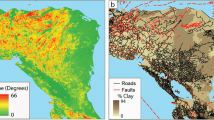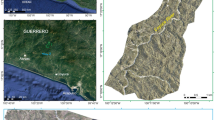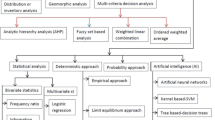Abstract
Landslides can have significant and pervasive impacts to life and property around the world. Several attempts have been made to predict the geographic distribution of landslide activity at continental and global scales. These efforts shared common traits such as resolution, modeling approach, and explanatory variables. The lessons learned from prior research have been applied to build a new global susceptibility map from existing and previously unavailable data. Data on slope, faults, geology, forest loss, and road networks were combined using a heuristic fuzzy approach. The map was evaluated with a Global Landslide Catalog developed at the National Aeronautics and Space Administration, as well as several local landslide inventories. Comparisons to similar susceptibility maps suggest that the subjective methods commonly used at this scale are, for the most part, reproducible. However, comparisons of landslide susceptibility across spatial scales must take into account the susceptibility of the local subset relative to the larger study area. The new global landslide susceptibility map is intended for use in disaster planning, situational awareness, and for incorporation into global decision support systems.







Similar content being viewed by others
References
Ahmed MF, Rogers JD, Ismail EH (2014) A regional level preliminary landslide susceptibility study of the upper Indus river basin. Eur J Remote Sens 47:343–373. doi:10.5721/EuJRS20144721
Ayalew L, Yamagishi H (2005) The application of GIS-based logistic regression for landslide susceptibility map** in the Kakuda-Yahiko Mountains, Central Japan. Geomorphology 65:15–31. doi:10.1016/j.geomorph.2004.06.010
Beguería S (2006) Changes in land cover and shallow landslide activity: a case study in the Spanish Pyrenees. Geomorphology 74:196–206. doi:10.1016/j.geomorph.2005.07.018
Bhatt BP, Awasthi KD, Heyojoo BP et al (2013) Using geographic information system and analytical hierarchy process in landslide hazard zonation. Appl Ecol Environ Sci 1:14–22. doi:10.12691/aees-1-2-1
BMTPC (Building Materials and Technology Promotion Council Ministry of Urban Development and Poverty Alleviation Government of India), CDMM (Centre for Disaster Mitigation and Management, Anna University) (2003) Landslide Hazard Zonation Atlas of India. New Delhi
Bonham-Carter G (1994) Geographic information systems for geoscientists: modelling with GIS. Elsevier, Amsterdam
Bouysse P (2009) Geological map of the world at 1:50 000 000. Commission for the Geological Map of the World
Brabb EE, Colgan JP, Best TC (1999) Map showing inventory and regional susceptibility for Holocene debris flows and related fast moving landslides in the conterminous United States. Accessed http://pubs.usgs.gov/mf/1999/2329/
Bucknam RC, Coe JA, Chavarría MM et al (2001) Landslides triggered by Hurricane Mitch in Guatemala—inventory and discussion. US Geological Survey Open File Report 01-443:38
Center for International Earth Science Information Network, Information Technology Outreach Services (2013) Global roads open access data set, version 1. http://sedac.ciesin.columbia.edu/data/set/groads-global-roads-open-access-v1. Accessed 1 Jan 2015
Cepeda J, Smebye, H, Vangelsten, B et al (2010) Landslide risk in Indonesia. Global assessment report on disaster risk reduction. United Nations
Champati ray PK, Dimri S, Lakhera RC, Sati S (2007) Fuzzy-based method for landslide hazard assessment in active seismic zone of Himalaya. Landslides 4:101–111. doi:10.1007/s10346-006-0068-6
Dahal RK, Hasegawa S, Nonomura A et al (2008) Predictive modelling of rainfall-induced landslide hazard in the Lesser Himalaya of Nepal based on weights-of-evidence. Geomorphology 102:496–510. doi:10.1016/j.geomorph.2008.05.041
de Ferranti J (2014a) Digital Elevation Data—with SRTM voids filled using accurate topographic map**. http://www.viewfinderpanoramas.org/dem3.html. Accessed 17 Nov 2015
de Ferranti J (2014b) Digital Elevation Data: SRTM void fill. http://viewfinderpanoramas.org/voidfill.html. Accessed 19 May 2016
Devoli G, Morales A, Høeg K (2007a) Historical landslides in Nicaragua—collection and analysis of data. Landslides 4:5–18. doi:10.1007/s10346-006-0048-x
Devoli G, Strauch W, Chávez G, Høeg K (2007b) A landslide database for Nicaragua: a tool for landslide-hazard management. Landslides 4:163–176. doi:10.1007/s10346-006-0074-8
DOGAMI (Oregon Department of Geology and Mineral Industries) (2015) SLIDO: statewide landslide information layer for Oregon. http://www.oregongeology.org/sub/slido/data.htm. Accessed 11 Oct 2015
dos Santos Alvalá RC, Camarinha PIM, Canavesi V (2013) Landslide susceptibility map** in the coastal region in the State of São Paulo, Brazil. In: American Geophysical Union, Spring Meeting
Elliott AH, Harty KM (2010) Landslide maps of Utah. Utah Geological Survey Map 246DM:14. 46 plates. 1:100,000 scale. DVD
ESRI (2013) ArcGIS Desktop, version 10.2. Environmental Systems Research Institute, Redlands, California
Frolova JV, Gvozdeva IP, Kuznetsov NP (2015) Effects of Hydrothermal Alterations on Physical and Mechanical Properties of Rocks in the Geysers Valley (Kamchatka Peninsula) in Connection with Landslide Development. In: Proceedings World Geothermal Congress 2015, pp 1–6
Gerencia de Geología (2012) Landslide inventory of El Salvador. Ministerio de Medio Ambiente y Recursos Naturales, El Salvador
Günther A, Van Den Eeckhaut M, Malet J-P et al (2014) Climate-physiographically differentiated Pan-European landslide susceptibility assessment using spatial multi-criteria evaluation and transnational landslide information. Geomorphology 224:69–85. doi:10.1016/j.geomorph.2014.07.011
Guzzetti F, Cardinali M, Reichenbach P (1994) The AVI project: a bibliographical and archive inventory of landslides and floods in Italy. Environ Manag 18:623–633. doi:10.1007/BF02400865
Haigh MJ, Rawat JS, Bartarya SK (1989) Environmental indicators of landslide activity along the Kilbury road, Nainital, Kumaun lesser Himalaya. Mt Res Dev 9:25–33
Haigh MJ, Rawat JS, Rawat MS et al (1995) Interactions between forest and landslide activity along new highways in the Kumaun Himalaya. For Ecol Manag 78:173–189
Hansen MC, Potapov PV, Moore R et al (2013) High-resolution global maps of 21st-century forest cover change. Science 342:850–853. doi:10.1126/science.1244693
Haque U, Blum P, da Silva PF et al (2016) Fatal landslides in Europe. Landslides. doi:10.1007/s10346-016-0689-3
Hijmans RJ (2015) Raster: geographic data analysis and modeling. R package version 2.4-15. https://CRAN.R-project.org/package=raster
Hirano A, Welch R, Lang H (2003) Map** from ASTER stereo image data: DEM validation and accuracy assessment. ISPRS J Photogramm Remote Sens 57:356–370. doi:10.1016/S0924-2716(02)00164-8
Hong Y, Adler RF, Huffman G (2007) Use of satellite remote sensing data in the map** of global landslide susceptibility. Nat Hazards 43:245–256. doi:10.1007/s11069-006-9104-z
Hosmer DW, Lemeshow S (2005) Assessing the fit of the model. In: Applied logistic regression, 2nd edn. Wiley, Inc., Hoboken, NJ, USA, pp 143–202
ICIMOD (International Centre for Integrated Mountain Development) (1992) Landslides in Koshi River Basin of 1990. http://rds.icimod.org/Home/DataDetail?metadataId=23175&searchlist=True. Accessed 7 Jan 2015
ICIMOD (International Centre for Integrated Mountain Development) (2010) Landslides in Koshi River Basin of 2010. http://rds.icimod.org/Home/DataDetail?metadataId=23176&searchlist=True. Accessed 7 Jan 2015
Jarvis A, Reuter H, Nelson A, Guevara E (2008) Hole-filled SRTM for the globe version 4. Available from the CGIAR-CSI SRTM 90 m Database
Jezek KC (2002) RADARSAT-1 Antarctic map** project: change-detection and surface velocity campaign. Ann Glaciol 34:263–268. doi:10.3189/172756402781818030
Keefer DK (1994) The importance of earthquake-induced landslides to long-term slope erosion and slope-failure hazards in seismically active regions. Geomorphology 10:265–284. doi:10.1016/0169-555X(94)90021-3
Kirschbaum DB, Adler RF, Hong Y et al (2010) A global landslide catalog for hazard applications: method, results, and limitations. Nat Hazards 52:561–575. doi:10.1007/s11069-009-9401-4
Kirschbaum D, Stanley T (2016) A satellite-based global landslide hazard assessment model for situational awareness. In: Geological society of america abstracts with programs, vol 48. doi:10.1130/abs/2016AM-279271
Kirschbaum DB, Stanley T, Yatheendradas S (2015a) Modeling landslide susceptibility over large regions with fuzzy overlay. Landslides. doi:10.1007/s10346-015-0577-2
Kirschbaum DB, Stanley T, Zhou Y (2015b) Spatial and temporal analysis of a global landslide catalog. Geomorphology 249:4–15. doi:10.1016/j.geomorph.2015.03.016
Korup O, Stolle A (2014) Landslide prediction from machine learning. Geol Today 30:26–33. doi:10.1111/gto.12034
Larsen IJ, Montgomery DR (2012) Landslide erosion coupled to tectonics and river incision. Nat Geosci 5:468–473. doi:10.1038/ngeo1479
Larsen MC, Parks JE (1997) How wide is a road? The association of roads and mass-wasting in a forested montane environment. Earth Surf Process Landf 22:835–848. doi:10.1002/(SICI)1096-9837(199709)22:9<835:AID-ESP782>3.0.CO;2-C
Lehner B, Verdin K, Jarvis A (2008) New global hydrography derived from spaceborne elevation data. EOS Trans Am Geophys Union 89:93. doi:10.1029/2008EO100001
Liu C, Li W, Wu H et al (2013) Susceptibility evaluation and map** of China’s landslides based on multi-source data. Nat Hazards 69:1477–1495. doi:10.1007/s11069-013-0759-y
Nadim F, Kjekstad O, Peduzzi P et al (2006) Global landslide and avalanche hotspots. Landslides 3:159–173. doi:10.1007/s10346-006-0036-1
NIMA (National Imagery and Map** Agency) (1993) Vector map (VMap) level 0. http://earth-info.nga.mil/publications/vmap0.html. Accessed 1 Jan 2014
Okamoto T, Sakurai M, Tsuchiya S (2013) Secondary hazards associated with coseismic landslide. In: Ugai K, Yagi H, Wakai A (eds) Earthquake-induced landslides. Springer, Berlin, pp 77–82
OpenStreetMap contributors (2015) OpenStreetMap. http://osm-x-tractor.org/Data.aspx. Accessed 7 Jun 2015
Petley DN (2012) Global patterns of loss of life from landslides. Geology 40:927–930. doi:10.1130/G33217.1
Petley DN, Dunning SA, Rosser NJ (2005) The analysis of global landslide risk through the creation of a database of worldwide landslide fatalities. In: Hungr O, Fell R, Couture R, Eberhardt E (eds) Landslide risk management. CRC Press, Boca Raton, p 776
Petley DN, Hearn GJ, Hart A et al (2007) Trends in landslide occurrence in Nepal. Nat Hazards 43:23–44. doi:10.1007/s11069-006-9100-3
Pradhan B (2011) Use of GIS-based fuzzy logic relations and its cross application to produce landslide susceptibility maps in three test areas in Malaysia. Environ Earth Sci 63:329–349. doi:10.1007/s12665-010-0705-1
Rabus B, Eineder M, Roth A, Bamler R (2003) The shuttle radar topography mission—a new class of digital elevation models acquired by spaceborne radar. ISPRS J Photogramm Remote Sens 57:241–262. doi:10.1016/S0924-2716(02)00124-7
Radbruch-Hall DH, Colton RB, Davies WE et al (1982) Landslide overview map of the conterminous United States. U.S Government Printing Office, Washington
Regmi AD, Devkota KC, Yoshida K et al (2013) Application of frequency ratio, statistical index, and weights-of-evidence models and their comparison in landslide susceptibility map** in Central Nepal Himalaya. Arab J Geosci 7:725–742. doi:10.1007/s12517-012-0807-z
Reid ME, Sisson TW, Brien DL (2001) Volcano collapse promoted by hydrothermal alteration and edifice shape, Mount Rainier, Washington. Geology 29:779. doi:10.1130/0091-7613(2001)029<0779:VCPBHA>2.0.CO;2
Rubel Y, Ahmed B (2013) Understanding the issues involved in urban landslide vulnerability in Chittagong metropolitan area. Association of American Geographers (AAG), Bangladesh
Scheidegger AE, Ai NS (1986) Tectonic processes and geomorphological design. Tectonophysics 126:285–300. doi:10.1016/0040-1951(86)90234-9
Schutz BE, Zwally HJ, Shuman CA et al (2005) Overview of the ICESat mission. Geophys Res Lett 32:L21S01. doi:10.1029/2005GL024009
Sidle RC, Pearce AJ, O’Loughlin CL (1985) Effects of land management on soil mass movement. In: Sidle RC, Pearce AJ, O’Loughlin CL (eds) Hillslope stability and land use. American Geophysical Union, Washington, pp 73–88
Sidle RC, Ziegler AD, Negishi JN et al (2006) Erosion processes in steep terrain—truths, myths, and uncertainties related to forest management in Southeast Asia. For Ecol Manag 224:199–225. doi:10.1016/j.foreco.2005.12.019
Srivastava V, Srivastava HB, Lakhera RC (2010) Fuzzy gamma based geomatic modelling for landslide hazard susceptibility in a part of Tons river valley, northwest Himalaya, India. Geomat Nat Hazards Risk 1:225–242. doi:10.1080/19475705.2010.490103
Steger S, Brenning A, Bell R et al (2016a) Exploring discrepancies between quantitative validation results and the geomorphic plausibility of statistical landslide susceptibility maps. Geomorphology 262:8–23. doi:10.1016/j.geomorph.2016.03.015
Steger S, Brenning A, Bell R, Glade T (2016b) The impact of systematically incomplete and positionally inaccurate landslide inventories on statistical landslide susceptibility models. In: EGU general assembly conference abstracts 18:6666
Tangestani MH (2004) Landslide susceptibility map** using the fuzzy gamma approach in a GIS, Kakan catchment area, southwest Iran. Aust J Earth Sci 51:439–450. doi:10.1111/j.1400-0952.2004.01068.x
USGS (United States Geological Survey) (2008) Global land survey digital elevation model. Global Land Cover Facility, University of Maryland, College Park, Maryland. http://glcf.umd.edu/data/glsdem/
van Westen CJ, Castellanos E, Kuriakose SL (2008) Spatial data for landslide susceptibility, hazard, and vulnerability assessment: an overview. Eng Geol 102:112–131. doi:10.1016/j.enggeo.2008.03.010
Verdin KL, Godt JW, Funk C et al (2007) Development of a global slope dataset for estimation of landslide occurrence resulting from earthquakes: U.S. Geological Survey, Colorado. Open-File Report 2007–1188:25
Weirich F, Blesius L (2007) Comparison of satellite and air photo based landslide susceptibility maps. Geomorphology 87:352–364. doi:10.1016/j.geomorph.2006.10.003
Zhang J, Gurung DR, Liu R et al (2015) Abe Barek landslide and landslide susceptibility assessment in Badakhshan Province, Afghanistan. Landslides 12:597–609. doi:10.1007/s10346-015-0558-5
Zweig MH, Campbell G (1993) Receiver-operating characteristic (ROC) plots: a fundamental evaluation tool in clinical medicine. Clin Chem 39:561–577
Acknowledgements
Thank you to all of the contributors to the Global Landslide Catalog since its creation in 2007. Thank you also to all of those who provided landslide inventories for analysis, including Deo Raj Gurung and Jianqiang Zhang (ICIMOD), Mauro Rossi (CNR IRPI), Graziella Devoli, Manuel Diaz (MARN), the Oregon DOGAMI, the USGS, and the Utah Geological Survey. This work was supported by NASA’s Precipitation Measurement Missions.
Author information
Authors and Affiliations
Corresponding author
Rights and permissions
About this article
Cite this article
Stanley, T., Kirschbaum, D.B. A heuristic approach to global landslide susceptibility map**. Nat Hazards 87, 145–164 (2017). https://doi.org/10.1007/s11069-017-2757-y
Received:
Accepted:
Published:
Issue Date:
DOI: https://doi.org/10.1007/s11069-017-2757-y




